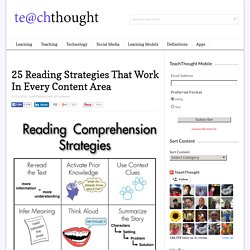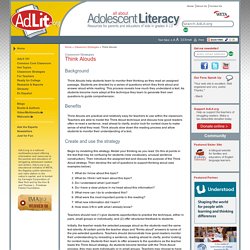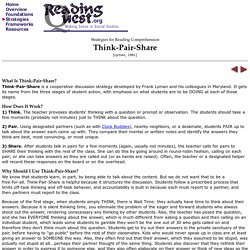

25 Reading Strategies That Work In Every Content Area. 25 Reading Strategies That Work In Every Content Area Reading is reading.

By understanding that letters make sounds, we can blend those sounds together to make whole sounds that symbolize meaning we can all exchange with one another. Without getting too Platonic about it all, reading doesn’t change simply because you’re reading a text from another content area. Only sometimes it does. Science content can often by full of jargon, research citations, and odd text features. Social Studies content can be an interesting mix of itemized information, and traditional paragraphs/imagery. Literature? This all makes reading strategies somewhat content area specific. But if you’d like to start with a basic set of strategies, you could do worse than the elegant graphic above from wiki-teacher.com.
For related reading, see 50 of the best reading comprehension apps, different ways your school can promote literacy, or how reading in the 21st century is different. Inquiry Chart. Think Alouds. Classroom Strategies Background Think Alouds help students learn to monitor their thinking as they read an assigned passage.

Students are directed by a series of questions which they think about and answer aloud while reading. This process reveals how much they understand a text. As students become more adept at this technique they learn to generate their own questions to guide comprehension. Benefits Think Alouds are practical and relatively easy for teachers to use within the classroom.
Create and use the strategy Begin by modeling this strategy. What do I know about this topic? Teachers should next (1) give students opportunities to practice the technique, either in pairs, small groups or individually; and (2) offer structured feedback to students. Initially, the teacher reads the selected passage aloud as the students read the same text silently. Further reading Davey, B. (1983). Olshavsky, J. Wilhelm, J. Wilhelm, J. Model Think-Aloud strategy on Vimeo#at=5. Story Maps. Think-Pair-Share. Resources for educators of kids in grades 4-12. FREEBIE READING STRATEGIES POSTERS & BOOKMARKS. Student Fishbowl. Student Fishbowl This activity requires 60-90 minutes.

Purpose: Fishbowl activities force participants to listen actively to the experiences and perspectives of a specific group of people. A student fishbowl gives pre-service and in-service educators an opportunity to hear the experiences, ideas, and feedback of current students while giving the students an opportunity to be active in the dialogue on educational equity. Preparation: The only major resources needed for this activity are current K-12 students. To prepare for the actual fishbowl dialogue, ask the fishbowl students to sit in a circle in the middle of the room.
Instructions: The following steps will set the ground rules, then initiate and process the dialogue for the student fishbowl activity: One important ground rule must guide the participation of the observers: During the course of the fishbowl, observers are not allowed to speak. Facilitator Notes: Think-Pair-Share. Strategies for Reading ComprehensionThink-Pair-Share[Lyman, 1981] What Is Think-Pair-Share?

Think-Pair-Share is a cooperative discussion strategy developed by Frank Lyman and his colleagues in Maryland. It gets its name from the three stages of student action, with emphasis on what students are to be DOING at each of those stages. How Does It Work? Strategies for Better Reading. 25 Reading Strategies That Work In Every Content Area. 6 Scaffolding Strategies to Use with Your Students. What’s the opposite of scaffolding a lesson? Saying to students, “Read this nine-page science article, write a detailed essay on the topic it explores, and turn it in by Wednesday.”
Yikes! No safety net, no parachute—they’re just left to their own devices. Let’s start by agreeing that scaffolding a lesson and differentiating instruction are two different things. Scaffolding is breaking up the learning into chunks and providing a tool, or structure, with each chunk. Simply put, scaffolding is what you do first with kids. Scaffolding and differentiation do have something in common, though. So let’s get to some scaffolding strategies you may or may not have tried yet. 1. How many of us say that we learn best by seeing something rather than hearing about it? Try a fishbowl activity, where a small group in the center is circled by the rest of the class; the group in the middle, or fishbowl, engages in an activity, modeling how it’s done for the larger group.